Analyzing Management Functions, Structure, Culture, and Talent Impact
VerifiedAdded on 2023/06/15
|8
|1903
|271
Report
AI Summary
This report provides a comprehensive analysis of management functions, organizational structures, and talent management within an organization. It begins by examining different types of organizational structures, including functional and divisional structures, highlighting their respective advantages and disadvantages. The report then discusses the roles and responsibilities of various business functions such as production, research and development, and purchasing. It also explores how the marketing department collaborates with other departments like finance, HRM, and sales to achieve organizational success. Further, the report delves into the core management functions of planning, organizing, commanding, coordinating, and controlling, emphasizing the relationship between planning and controlling. Finally, it analyzes talent management, the role of human resources, different types of organizational culture (androcracy, clan, hierarchy, and market culture), and the consequences of strong and weak cultures within an organization. The report concludes that effective management functions and a strong organizational culture are essential for achieving organizational goals.
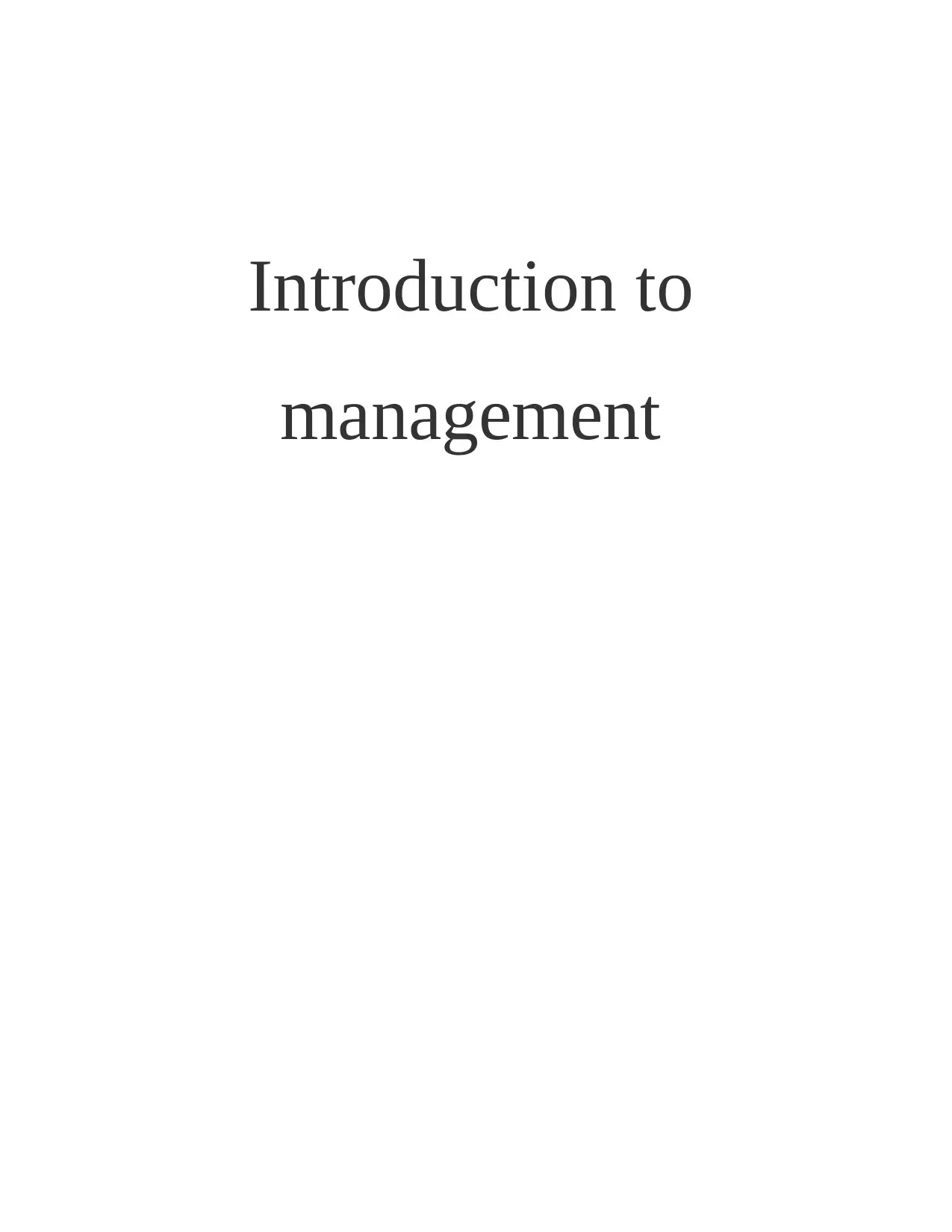
Introduction to
management
management
Paraphrase This Document
Need a fresh take? Get an instant paraphrase of this document with our AI Paraphraser
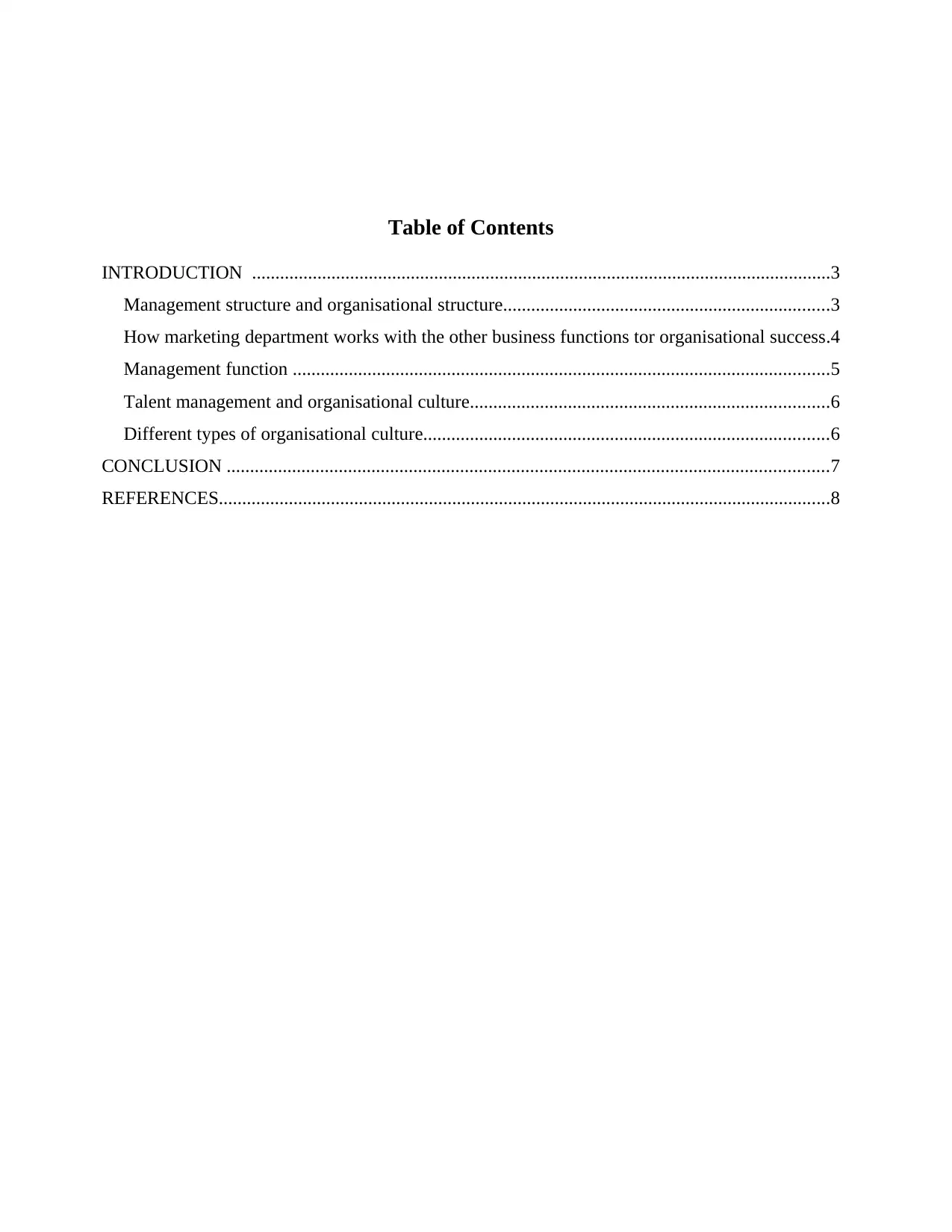
Table of Contents
INTRODUCTION ............................................................................................................................3
Management structure and organisational structure......................................................................3
How marketing department works with the other business functions tor organisational success.4
Management function ...................................................................................................................5
Talent management and organisational culture.............................................................................6
Different types of organisational culture.......................................................................................6
CONCLUSION .................................................................................................................................7
REFERENCES...................................................................................................................................8
INTRODUCTION ............................................................................................................................3
Management structure and organisational structure......................................................................3
How marketing department works with the other business functions tor organisational success.4
Management function ...................................................................................................................5
Talent management and organisational culture.............................................................................6
Different types of organisational culture.......................................................................................6
CONCLUSION .................................................................................................................................7
REFERENCES...................................................................................................................................8
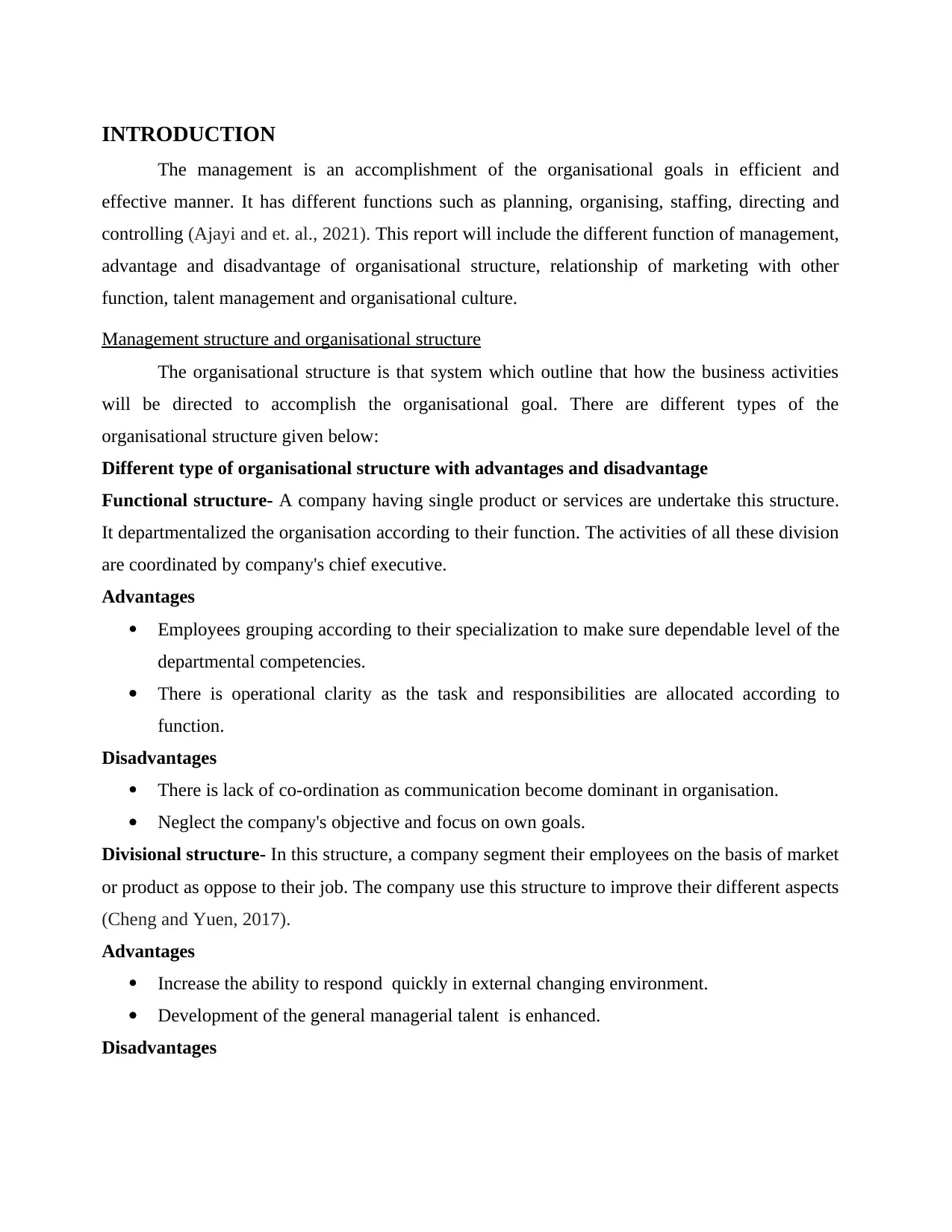
INTRODUCTION
The management is an accomplishment of the organisational goals in efficient and
effective manner. It has different functions such as planning, organising, staffing, directing and
controlling (Ajayi and et. al., 2021). This report will include the different function of management,
advantage and disadvantage of organisational structure, relationship of marketing with other
function, talent management and organisational culture.
Management structure and organisational structure
The organisational structure is that system which outline that how the business activities
will be directed to accomplish the organisational goal. There are different types of the
organisational structure given below:
Different type of organisational structure with advantages and disadvantage
Functional structure- A company having single product or services are undertake this structure.
It departmentalized the organisation according to their function. The activities of all these division
are coordinated by company's chief executive.
Advantages
Employees grouping according to their specialization to make sure dependable level of the
departmental competencies.
There is operational clarity as the task and responsibilities are allocated according to
function.
Disadvantages
There is lack of co-ordination as communication become dominant in organisation.
Neglect the company's objective and focus on own goals.
Divisional structure- In this structure, a company segment their employees on the basis of market
or product as oppose to their job. The company use this structure to improve their different aspects
(Cheng and Yuen, 2017).
Advantages
Increase the ability to respond quickly in external changing environment.
Development of the general managerial talent is enhanced.
Disadvantages
The management is an accomplishment of the organisational goals in efficient and
effective manner. It has different functions such as planning, organising, staffing, directing and
controlling (Ajayi and et. al., 2021). This report will include the different function of management,
advantage and disadvantage of organisational structure, relationship of marketing with other
function, talent management and organisational culture.
Management structure and organisational structure
The organisational structure is that system which outline that how the business activities
will be directed to accomplish the organisational goal. There are different types of the
organisational structure given below:
Different type of organisational structure with advantages and disadvantage
Functional structure- A company having single product or services are undertake this structure.
It departmentalized the organisation according to their function. The activities of all these division
are coordinated by company's chief executive.
Advantages
Employees grouping according to their specialization to make sure dependable level of the
departmental competencies.
There is operational clarity as the task and responsibilities are allocated according to
function.
Disadvantages
There is lack of co-ordination as communication become dominant in organisation.
Neglect the company's objective and focus on own goals.
Divisional structure- In this structure, a company segment their employees on the basis of market
or product as oppose to their job. The company use this structure to improve their different aspects
(Cheng and Yuen, 2017).
Advantages
Increase the ability to respond quickly in external changing environment.
Development of the general managerial talent is enhanced.
Disadvantages
⊘ This is a preview!⊘
Do you want full access?
Subscribe today to unlock all pages.

Trusted by 1+ million students worldwide
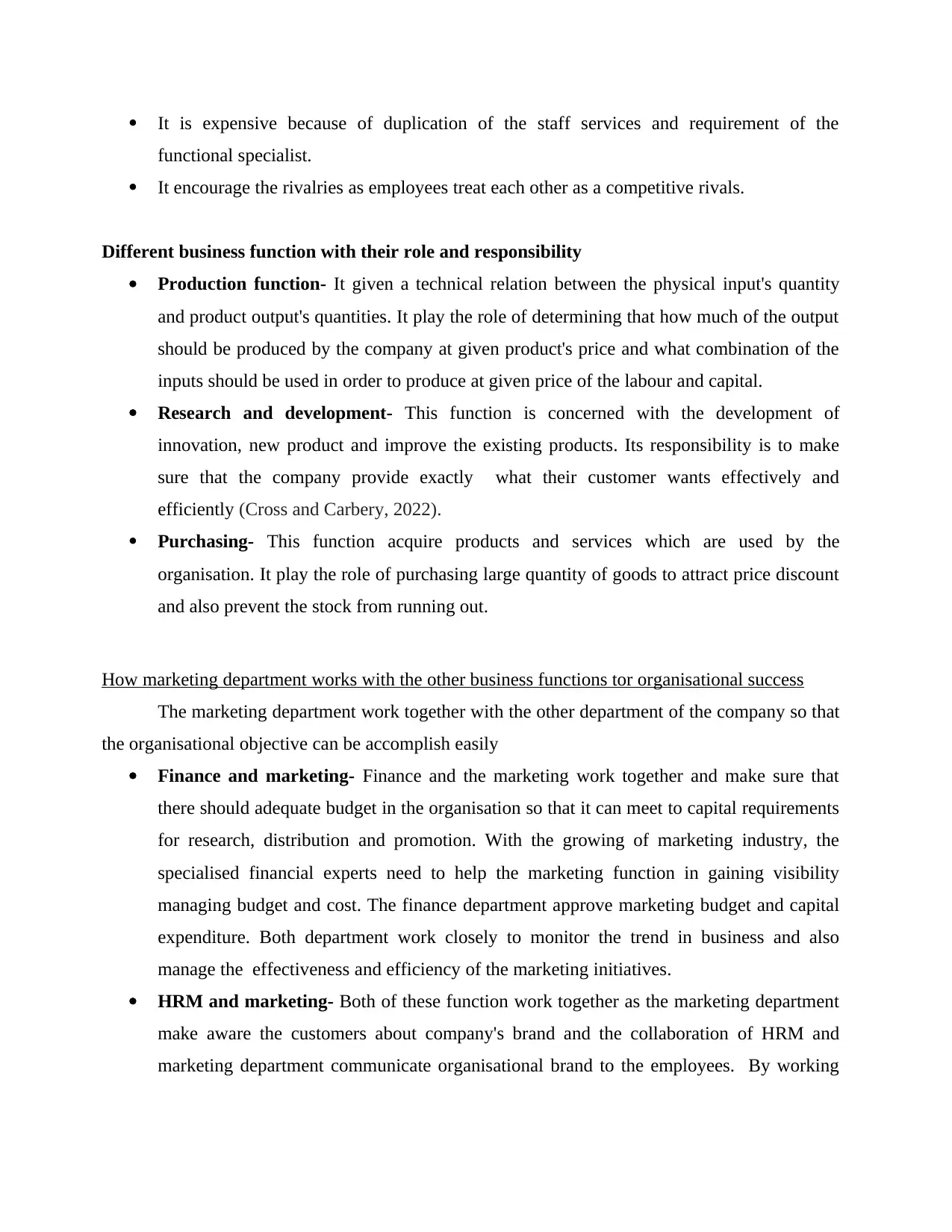
It is expensive because of duplication of the staff services and requirement of the
functional specialist.
It encourage the rivalries as employees treat each other as a competitive rivals.
Different business function with their role and responsibility
Production function- It given a technical relation between the physical input's quantity
and product output's quantities. It play the role of determining that how much of the output
should be produced by the company at given product's price and what combination of the
inputs should be used in order to produce at given price of the labour and capital.
Research and development- This function is concerned with the development of
innovation, new product and improve the existing products. Its responsibility is to make
sure that the company provide exactly what their customer wants effectively and
efficiently (Cross and Carbery, 2022).
Purchasing- This function acquire products and services which are used by the
organisation. It play the role of purchasing large quantity of goods to attract price discount
and also prevent the stock from running out.
How marketing department works with the other business functions tor organisational success
The marketing department work together with the other department of the company so that
the organisational objective can be accomplish easily
Finance and marketing- Finance and the marketing work together and make sure that
there should adequate budget in the organisation so that it can meet to capital requirements
for research, distribution and promotion. With the growing of marketing industry, the
specialised financial experts need to help the marketing function in gaining visibility
managing budget and cost. The finance department approve marketing budget and capital
expenditure. Both department work closely to monitor the trend in business and also
manage the effectiveness and efficiency of the marketing initiatives.
HRM and marketing- Both of these function work together as the marketing department
make aware the customers about company's brand and the collaboration of HRM and
marketing department communicate organisational brand to the employees. By working
functional specialist.
It encourage the rivalries as employees treat each other as a competitive rivals.
Different business function with their role and responsibility
Production function- It given a technical relation between the physical input's quantity
and product output's quantities. It play the role of determining that how much of the output
should be produced by the company at given product's price and what combination of the
inputs should be used in order to produce at given price of the labour and capital.
Research and development- This function is concerned with the development of
innovation, new product and improve the existing products. Its responsibility is to make
sure that the company provide exactly what their customer wants effectively and
efficiently (Cross and Carbery, 2022).
Purchasing- This function acquire products and services which are used by the
organisation. It play the role of purchasing large quantity of goods to attract price discount
and also prevent the stock from running out.
How marketing department works with the other business functions tor organisational success
The marketing department work together with the other department of the company so that
the organisational objective can be accomplish easily
Finance and marketing- Finance and the marketing work together and make sure that
there should adequate budget in the organisation so that it can meet to capital requirements
for research, distribution and promotion. With the growing of marketing industry, the
specialised financial experts need to help the marketing function in gaining visibility
managing budget and cost. The finance department approve marketing budget and capital
expenditure. Both department work closely to monitor the trend in business and also
manage the effectiveness and efficiency of the marketing initiatives.
HRM and marketing- Both of these function work together as the marketing department
make aware the customers about company's brand and the collaboration of HRM and
marketing department communicate organisational brand to the employees. By working
Paraphrase This Document
Need a fresh take? Get an instant paraphrase of this document with our AI Paraphraser
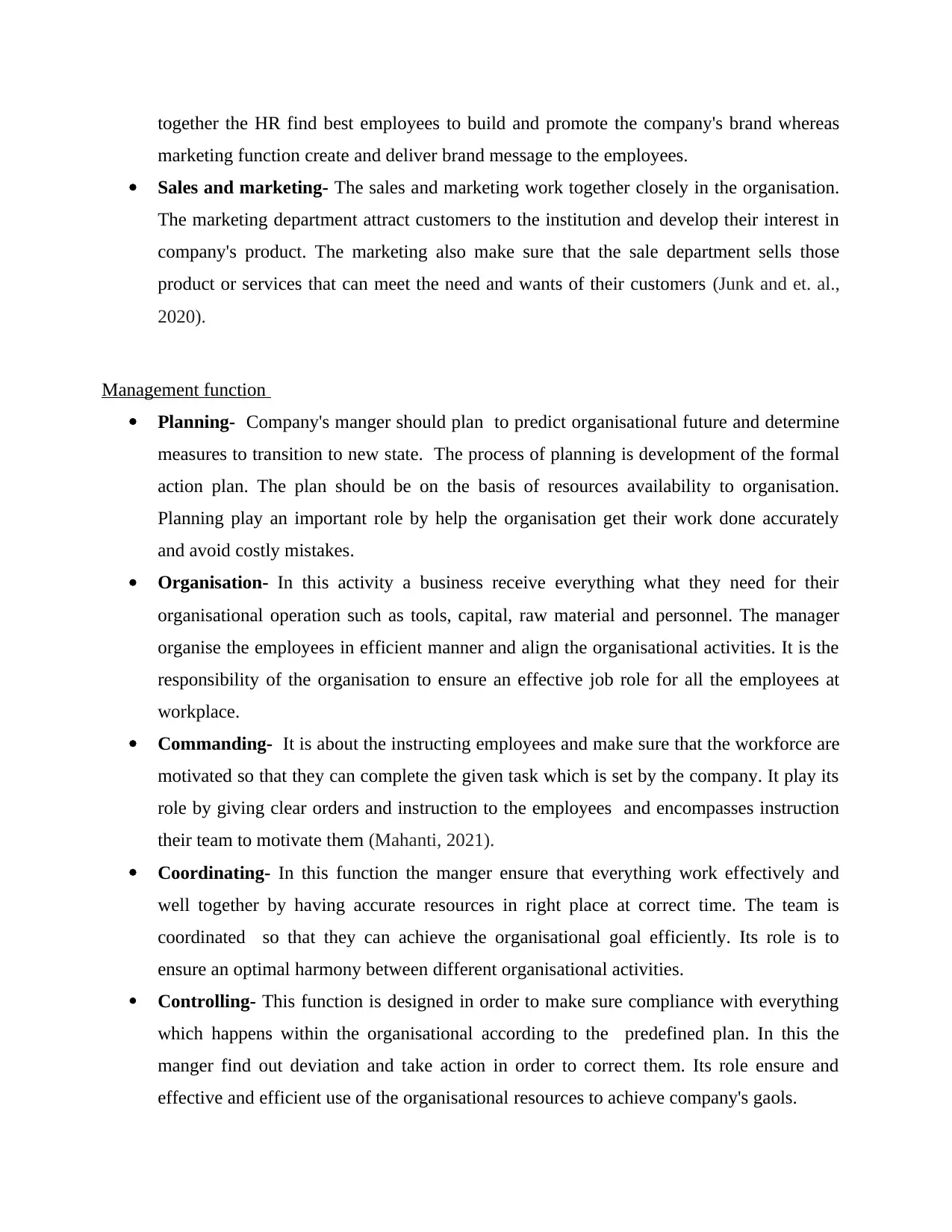
together the HR find best employees to build and promote the company's brand whereas
marketing function create and deliver brand message to the employees.
Sales and marketing- The sales and marketing work together closely in the organisation.
The marketing department attract customers to the institution and develop their interest in
company's product. The marketing also make sure that the sale department sells those
product or services that can meet the need and wants of their customers (Junk and et. al.,
2020).
Management function
Planning- Company's manger should plan to predict organisational future and determine
measures to transition to new state. The process of planning is development of the formal
action plan. The plan should be on the basis of resources availability to organisation.
Planning play an important role by help the organisation get their work done accurately
and avoid costly mistakes.
Organisation- In this activity a business receive everything what they need for their
organisational operation such as tools, capital, raw material and personnel. The manager
organise the employees in efficient manner and align the organisational activities. It is the
responsibility of the organisation to ensure an effective job role for all the employees at
workplace.
Commanding- It is about the instructing employees and make sure that the workforce are
motivated so that they can complete the given task which is set by the company. It play its
role by giving clear orders and instruction to the employees and encompasses instruction
their team to motivate them (Mahanti, 2021).
Coordinating- In this function the manger ensure that everything work effectively and
well together by having accurate resources in right place at correct time. The team is
coordinated so that they can achieve the organisational goal efficiently. Its role is to
ensure an optimal harmony between different organisational activities.
Controlling- This function is designed in order to make sure compliance with everything
which happens within the organisational according to the predefined plan. In this the
manger find out deviation and take action in order to correct them. Its role ensure and
effective and efficient use of the organisational resources to achieve company's gaols.
marketing function create and deliver brand message to the employees.
Sales and marketing- The sales and marketing work together closely in the organisation.
The marketing department attract customers to the institution and develop their interest in
company's product. The marketing also make sure that the sale department sells those
product or services that can meet the need and wants of their customers (Junk and et. al.,
2020).
Management function
Planning- Company's manger should plan to predict organisational future and determine
measures to transition to new state. The process of planning is development of the formal
action plan. The plan should be on the basis of resources availability to organisation.
Planning play an important role by help the organisation get their work done accurately
and avoid costly mistakes.
Organisation- In this activity a business receive everything what they need for their
organisational operation such as tools, capital, raw material and personnel. The manager
organise the employees in efficient manner and align the organisational activities. It is the
responsibility of the organisation to ensure an effective job role for all the employees at
workplace.
Commanding- It is about the instructing employees and make sure that the workforce are
motivated so that they can complete the given task which is set by the company. It play its
role by giving clear orders and instruction to the employees and encompasses instruction
their team to motivate them (Mahanti, 2021).
Coordinating- In this function the manger ensure that everything work effectively and
well together by having accurate resources in right place at correct time. The team is
coordinated so that they can achieve the organisational goal efficiently. Its role is to
ensure an optimal harmony between different organisational activities.
Controlling- This function is designed in order to make sure compliance with everything
which happens within the organisational according to the predefined plan. In this the
manger find out deviation and take action in order to correct them. Its role ensure and
effective and efficient use of the organisational resources to achieve company's gaols.
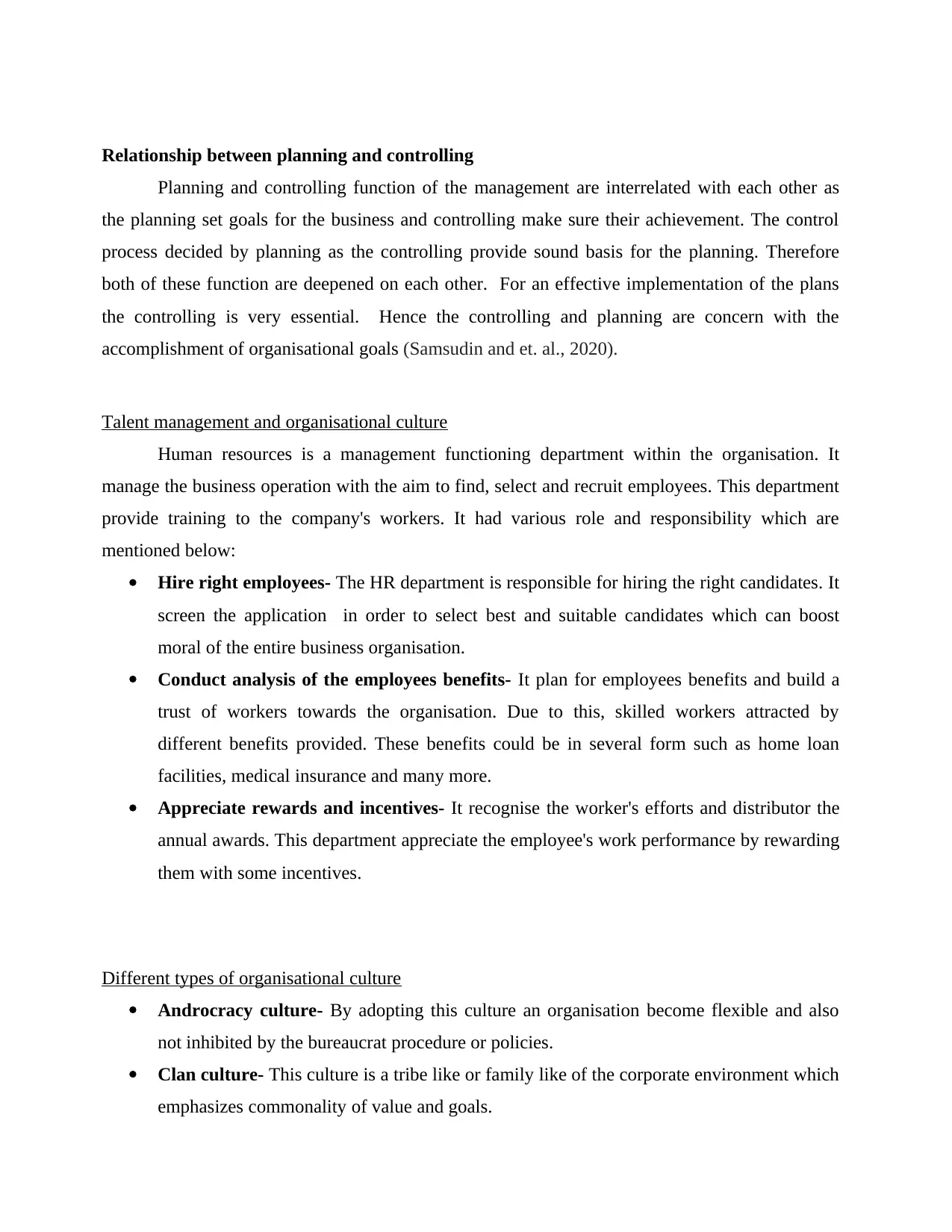
Relationship between planning and controlling
Planning and controlling function of the management are interrelated with each other as
the planning set goals for the business and controlling make sure their achievement. The control
process decided by planning as the controlling provide sound basis for the planning. Therefore
both of these function are deepened on each other. For an effective implementation of the plans
the controlling is very essential. Hence the controlling and planning are concern with the
accomplishment of organisational goals (Samsudin and et. al., 2020).
Talent management and organisational culture
Human resources is a management functioning department within the organisation. It
manage the business operation with the aim to find, select and recruit employees. This department
provide training to the company's workers. It had various role and responsibility which are
mentioned below:
Hire right employees- The HR department is responsible for hiring the right candidates. It
screen the application in order to select best and suitable candidates which can boost
moral of the entire business organisation.
Conduct analysis of the employees benefits- It plan for employees benefits and build a
trust of workers towards the organisation. Due to this, skilled workers attracted by
different benefits provided. These benefits could be in several form such as home loan
facilities, medical insurance and many more.
Appreciate rewards and incentives- It recognise the worker's efforts and distributor the
annual awards. This department appreciate the employee's work performance by rewarding
them with some incentives.
Different types of organisational culture
Androcracy culture- By adopting this culture an organisation become flexible and also
not inhibited by the bureaucrat procedure or policies.
Clan culture- This culture is a tribe like or family like of the corporate environment which
emphasizes commonality of value and goals.
Planning and controlling function of the management are interrelated with each other as
the planning set goals for the business and controlling make sure their achievement. The control
process decided by planning as the controlling provide sound basis for the planning. Therefore
both of these function are deepened on each other. For an effective implementation of the plans
the controlling is very essential. Hence the controlling and planning are concern with the
accomplishment of organisational goals (Samsudin and et. al., 2020).
Talent management and organisational culture
Human resources is a management functioning department within the organisation. It
manage the business operation with the aim to find, select and recruit employees. This department
provide training to the company's workers. It had various role and responsibility which are
mentioned below:
Hire right employees- The HR department is responsible for hiring the right candidates. It
screen the application in order to select best and suitable candidates which can boost
moral of the entire business organisation.
Conduct analysis of the employees benefits- It plan for employees benefits and build a
trust of workers towards the organisation. Due to this, skilled workers attracted by
different benefits provided. These benefits could be in several form such as home loan
facilities, medical insurance and many more.
Appreciate rewards and incentives- It recognise the worker's efforts and distributor the
annual awards. This department appreciate the employee's work performance by rewarding
them with some incentives.
Different types of organisational culture
Androcracy culture- By adopting this culture an organisation become flexible and also
not inhibited by the bureaucrat procedure or policies.
Clan culture- This culture is a tribe like or family like of the corporate environment which
emphasizes commonality of value and goals.
⊘ This is a preview!⊘
Do you want full access?
Subscribe today to unlock all pages.

Trusted by 1+ million students worldwide
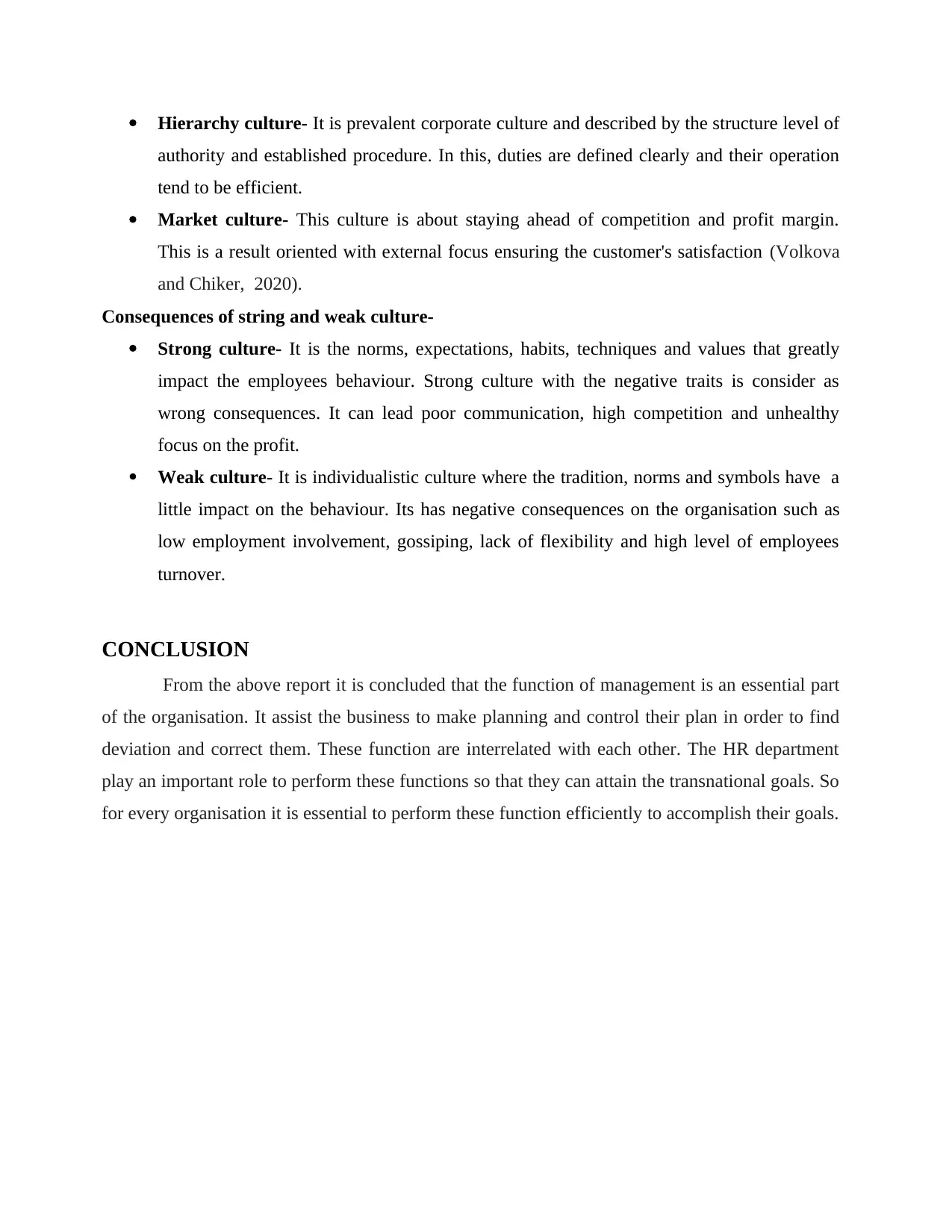
Hierarchy culture- It is prevalent corporate culture and described by the structure level of
authority and established procedure. In this, duties are defined clearly and their operation
tend to be efficient.
Market culture- This culture is about staying ahead of competition and profit margin.
This is a result oriented with external focus ensuring the customer's satisfaction (Volkova
and Chiker, 2020).
Consequences of string and weak culture-
Strong culture- It is the norms, expectations, habits, techniques and values that greatly
impact the employees behaviour. Strong culture with the negative traits is consider as
wrong consequences. It can lead poor communication, high competition and unhealthy
focus on the profit.
Weak culture- It is individualistic culture where the tradition, norms and symbols have a
little impact on the behaviour. Its has negative consequences on the organisation such as
low employment involvement, gossiping, lack of flexibility and high level of employees
turnover.
CONCLUSION
From the above report it is concluded that the function of management is an essential part
of the organisation. It assist the business to make planning and control their plan in order to find
deviation and correct them. These function are interrelated with each other. The HR department
play an important role to perform these functions so that they can attain the transnational goals. So
for every organisation it is essential to perform these function efficiently to accomplish their goals.
authority and established procedure. In this, duties are defined clearly and their operation
tend to be efficient.
Market culture- This culture is about staying ahead of competition and profit margin.
This is a result oriented with external focus ensuring the customer's satisfaction (Volkova
and Chiker, 2020).
Consequences of string and weak culture-
Strong culture- It is the norms, expectations, habits, techniques and values that greatly
impact the employees behaviour. Strong culture with the negative traits is consider as
wrong consequences. It can lead poor communication, high competition and unhealthy
focus on the profit.
Weak culture- It is individualistic culture where the tradition, norms and symbols have a
little impact on the behaviour. Its has negative consequences on the organisation such as
low employment involvement, gossiping, lack of flexibility and high level of employees
turnover.
CONCLUSION
From the above report it is concluded that the function of management is an essential part
of the organisation. It assist the business to make planning and control their plan in order to find
deviation and correct them. These function are interrelated with each other. The HR department
play an important role to perform these functions so that they can attain the transnational goals. So
for every organisation it is essential to perform these function efficiently to accomplish their goals.
Paraphrase This Document
Need a fresh take? Get an instant paraphrase of this document with our AI Paraphraser
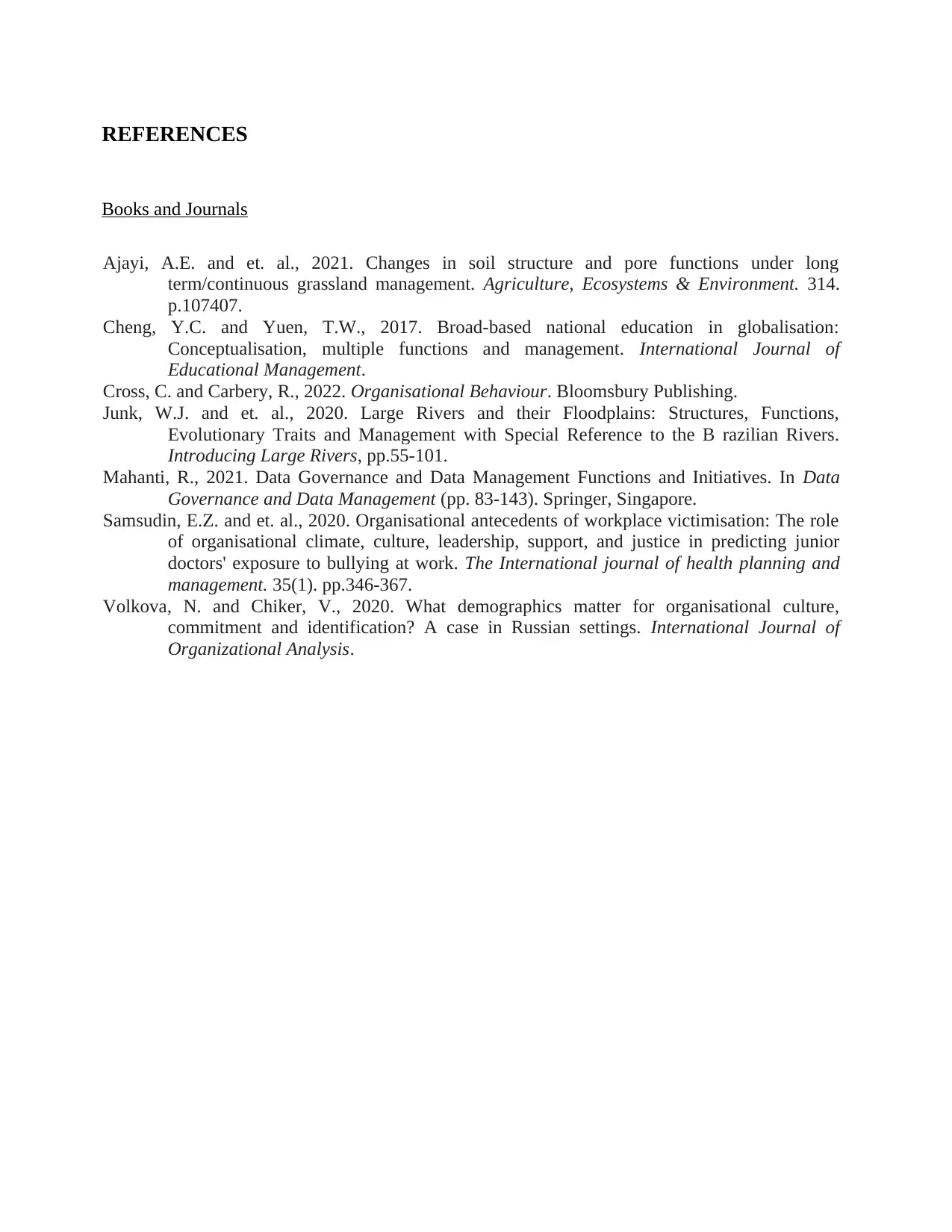
REFERENCES
Books and Journals
Ajayi, A.E. and et. al., 2021. Changes in soil structure and pore functions under long
term/continuous grassland management. Agriculture, Ecosystems & Environment. 314.
p.107407.
Cheng, Y.C. and Yuen, T.W., 2017. Broad-based national education in globalisation:
Conceptualisation, multiple functions and management. International Journal of
Educational Management.
Cross, C. and Carbery, R., 2022. Organisational Behaviour. Bloomsbury Publishing.
Junk, W.J. and et. al., 2020. Large Rivers and their Floodplains: Structures, Functions,
Evolutionary Traits and Management with Special Reference to the B razilian Rivers.
Introducing Large Rivers, pp.55-101.
Mahanti, R., 2021. Data Governance and Data Management Functions and Initiatives. In Data
Governance and Data Management (pp. 83-143). Springer, Singapore.
Samsudin, E.Z. and et. al., 2020. Organisational antecedents of workplace victimisation: The role
of organisational climate, culture, leadership, support, and justice in predicting junior
doctors' exposure to bullying at work. The International journal of health planning and
management. 35(1). pp.346-367.
Volkova, N. and Chiker, V., 2020. What demographics matter for organisational culture,
commitment and identification? A case in Russian settings. International Journal of
Organizational Analysis.
Books and Journals
Ajayi, A.E. and et. al., 2021. Changes in soil structure and pore functions under long
term/continuous grassland management. Agriculture, Ecosystems & Environment. 314.
p.107407.
Cheng, Y.C. and Yuen, T.W., 2017. Broad-based national education in globalisation:
Conceptualisation, multiple functions and management. International Journal of
Educational Management.
Cross, C. and Carbery, R., 2022. Organisational Behaviour. Bloomsbury Publishing.
Junk, W.J. and et. al., 2020. Large Rivers and their Floodplains: Structures, Functions,
Evolutionary Traits and Management with Special Reference to the B razilian Rivers.
Introducing Large Rivers, pp.55-101.
Mahanti, R., 2021. Data Governance and Data Management Functions and Initiatives. In Data
Governance and Data Management (pp. 83-143). Springer, Singapore.
Samsudin, E.Z. and et. al., 2020. Organisational antecedents of workplace victimisation: The role
of organisational climate, culture, leadership, support, and justice in predicting junior
doctors' exposure to bullying at work. The International journal of health planning and
management. 35(1). pp.346-367.
Volkova, N. and Chiker, V., 2020. What demographics matter for organisational culture,
commitment and identification? A case in Russian settings. International Journal of
Organizational Analysis.
1 out of 8
Related Documents
Your All-in-One AI-Powered Toolkit for Academic Success.
+13062052269
info@desklib.com
Available 24*7 on WhatsApp / Email
![[object Object]](/_next/static/media/star-bottom.7253800d.svg)
Unlock your academic potential
Copyright © 2020–2025 A2Z Services. All Rights Reserved. Developed and managed by ZUCOL.

